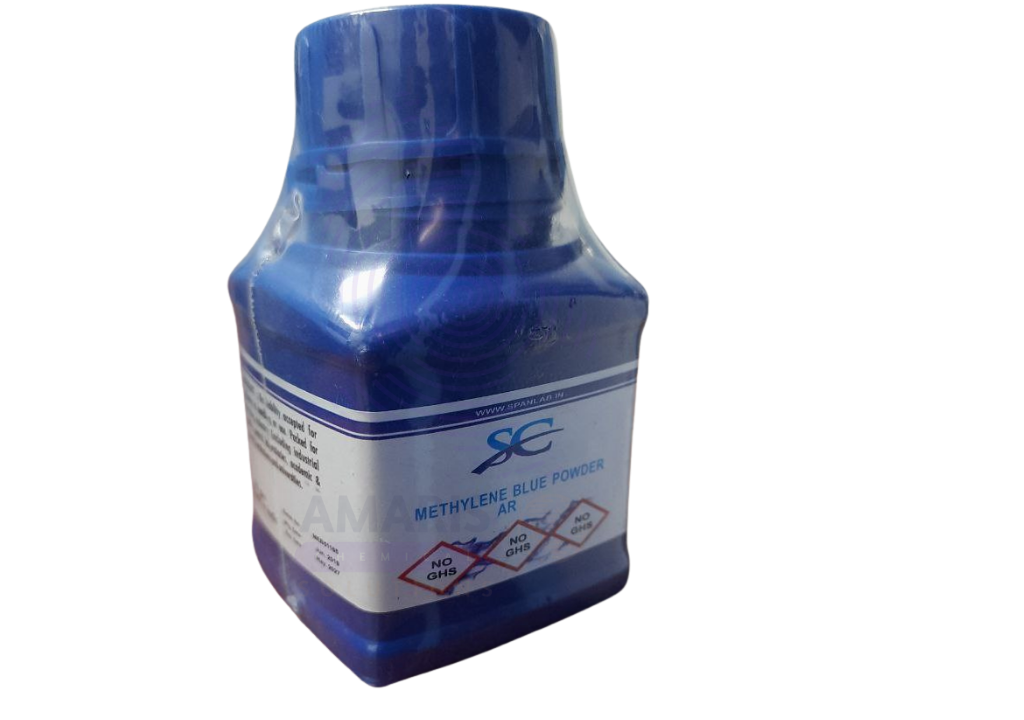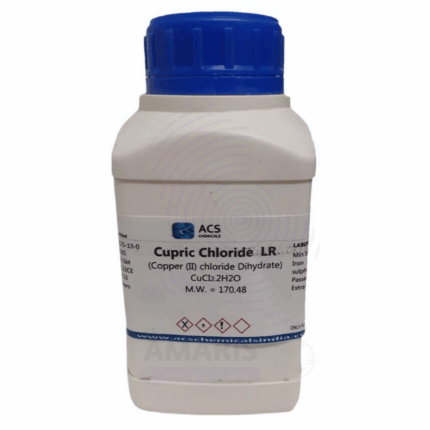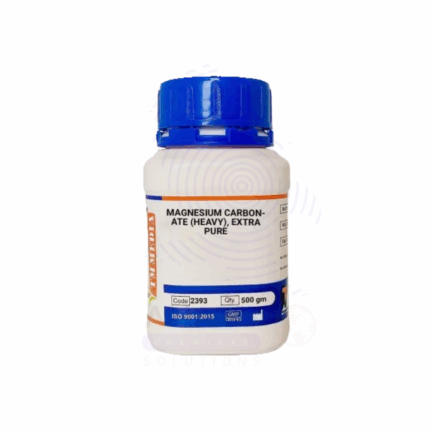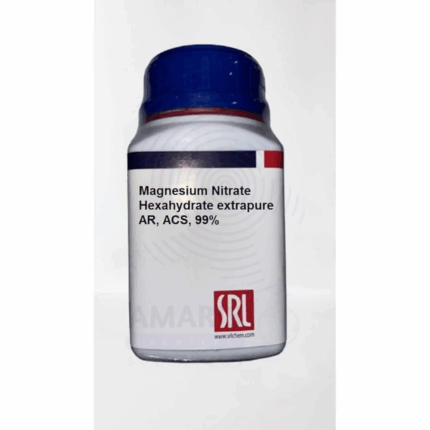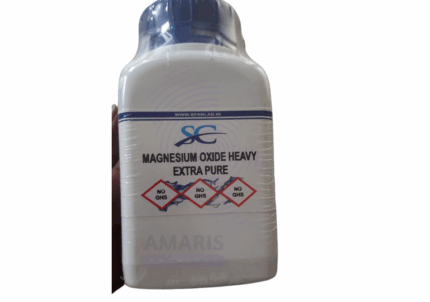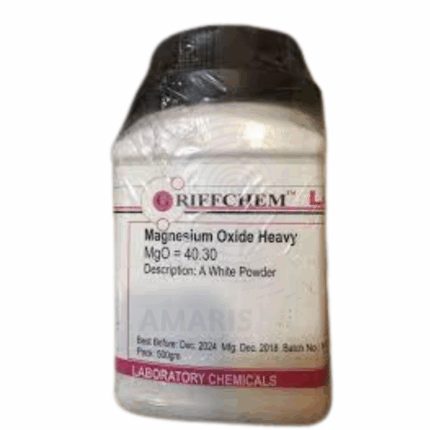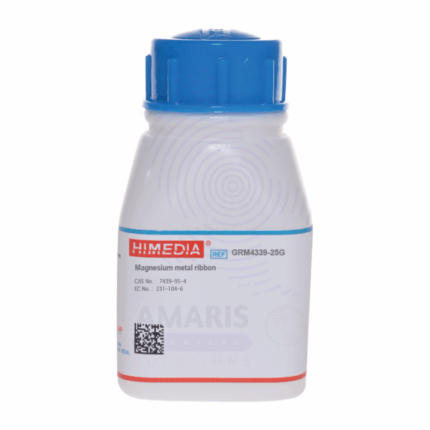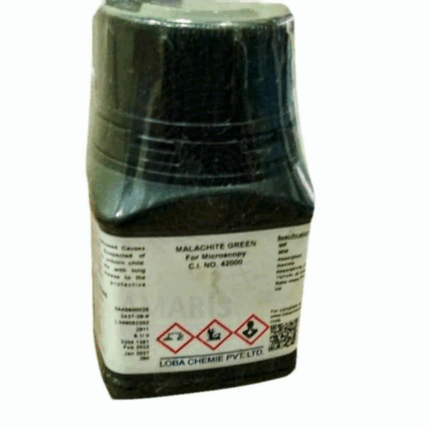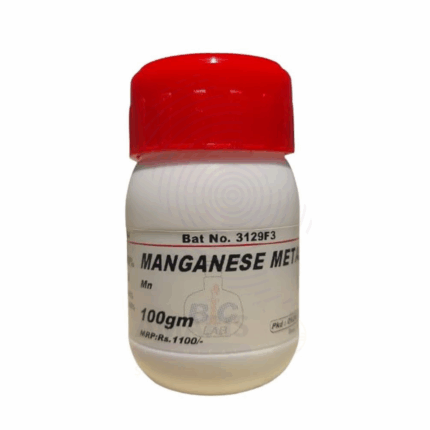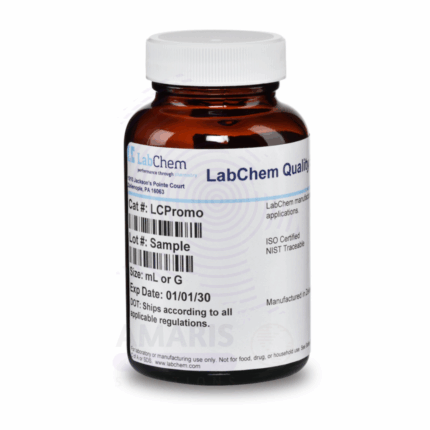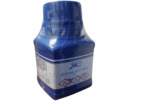
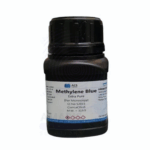
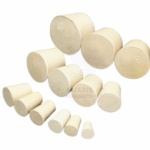
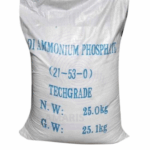
Methylene Blue Powder Extra Pure
$ 17.70 Original price was: $ 17.70.$ 17.63Current price is: $ 17.63.
Methylene Blue Powder Extra Pure is a high-grade dye with diverse laboratory and industrial applications. It is widely used as a biological stain in microscopy for highlighting cellular structures such as nuclei, bacteria, and parasites, particularly in blood smear and bacteriological studies. In chemistry, it serves as a redox indicator due to its distinct color change properties, and in aquaculture, it acts as a treatment for fungal and bacterial infections in fish. Its extra pure formulation ensures maximum staining clarity, minimal contamination, and reliable results in research, diagnostics, and educational settings.
Methylene Blue Powder Extra Pure
Primary Uses
- Biological Stain – Widely used for staining animal and bacterial cells (e.g., in microbiology and histology) to highlight cellular structures such as nuclei and cytoplasm.
- Redox Indicator – Serves as an oxidation-reduction indicator in various analytical chemistry applications.
Secondary Uses
- Aquaculture & Fish Medication – Used to treat fungal and bacterial infections in aquarium and hatchery settings.
- Research Reagent – Applied in studies involving mitochondrial respiration, membrane permeability, and nerve tissue viability.
- Dye in Microscopy Slides – Helps visualize cell morphology in prepared slide specimens.
| PACK SIZE |
25 grams Plastic Tin |
|---|
1. Basic Identification Attributes
- Chemical Name: Methylene Blue
- Synonyms: Basic Blue 9, Methylthioninium chloride
- Chemical Formula: C₁₆H₁₈ClN₃S
- CAS Number: 61-73-4
- Molecular Weight: 319.85 g/mol
- Appearance: Dark greenish-blue crystalline powder
- Odor: Odorless
- Solubility: Soluble in water and ethanol (forms deep blue solution)
- Grade: Extra Pure
2. Safety & Hazard Attributes
- GHS Classification:
- Eye Irritant (Category 2A)
- Skin Irritant (Category 2)
- Acute Toxicity (Oral, Category 4 — in large quantities)
- Hazard Statements:
- H302: Harmful if swallowed
- H315: Causes skin irritation
- H319: Causes serious eye irritation
- Precautionary Statements:
- P264: Wash hands thoroughly after handling
- P280: Wear protective gloves/eye protection
- P305+P351+P338: IF IN EYES: Rinse cautiously with water
- PPE Required:
- Gloves
- Lab coat
- Safety goggles or face shield
- First Aid:
- Eye Contact: Rinse cautiously with water
- Skin Contact: Wash with soap and water
- Inhalation: Remove to fresh air
- Ingestion: Rinse mouth and seek medical advice
- Fire Hazards:
- Not highly flammable
- Use water spray, CO₂, dry chemical for fire extinguishing
3. Storage & Handling
- Storage Conditions:
- Store in a tightly sealed container
- Keep in a cool, dry, and dark location
- Avoid moisture and strong oxidizing agents
- Handling Tips:
- Avoid dust formation
- Prevent skin or clothing contact—stains persistently
4. Laboratory Applications
- Primary Uses:
- Biological stain for microscopy (nuclei and bacteria visualization)
- Indicator in redox titrations
- Redox dye in electron transport chain studies
- Secondary Uses:
- Aquaculture and aquarium antiseptic
- Diagnostic reagent in medical and microbiological labs
- Photodynamic therapy research and oxidative stress studies
SAFETY PRECAUTIONS
Personal Protective Equipment (PPE):
- Wear a lab coat, nitrile gloves, and chemical safety goggles.
- Use a dust mask or work in a fume hood to avoid inhalation of fine powder.
Handling:
- Avoid contact with skin, eyes, and clothing.
- Prevent formation and inhalation of dust.
- Avoid ingestion.
- Wash hands thoroughly after handling.
Storage:
- Store in a tightly sealed container in a cool, dry, and well-ventilated area.
- Protect from moisture, light, and heat.
- Keep away from incompatible substances such as strong oxidizers and acids.
FIRST AID MEASURES
Inhalation:
- Move the person to fresh air immediately.
- Seek medical attention if symptoms like coughing or difficulty breathing occur.
Skin Contact:
- Wash affected areas thoroughly with soap and water.
- Remove contaminated clothing.
- Get medical advice if irritation or staining persists.
Eye Contact:
- Rinse eyes gently with plenty of water for at least 15 minutes.
- Remove contact lenses if present and easy to do.
- Seek medical attention.
Ingestion:
- Rinse mouth with water.
- Do not induce vomiting.
- Seek medical advice promptly.
FIRE FIGHTING MEASURES
Flammability:
- Not highly flammable but may burn if involved in a fire.
Extinguishing Media:
- Use dry chemicals, CO₂, or foam.
- Water spray can be used for cooling containers but may spread the powder.
Hazardous Combustion Products:
- May emit carbon oxides, sulfur oxides, and nitrogen oxides when decomposed.
Firefighter Protection:
- Use self-contained breathing apparatus (SCBA) and full protective gear.


 Preservatives(food)
Preservatives(food) Flavor Enhancers
Flavor Enhancers Acidulants
Acidulants Sweeteners
Sweeteners Antioxidants
Antioxidants Colorants(food)
Colorants(food) Nutraceutical Ingredients (food)
Nutraceutical Ingredients (food) Nutrient Supplements
Nutrient Supplements Emulsifiers
Emulsifiers
 Collectors
Collectors Dust Suppressants
Dust Suppressants Explosives and Blasting Agents
Explosives and Blasting Agents Flocculants and Coagulants
Flocculants and Coagulants Frothers
Frothers Leaching Agents
Leaching Agents pH Modifiers
pH Modifiers Precious Metal Extraction Agents
Precious Metal Extraction Agents
 Antioxidants(plastic)
Antioxidants(plastic) Colorants (Pigments, Dyes)
Colorants (Pigments, Dyes) Fillers and Reinforcements
Fillers and Reinforcements Flame Retardants
Flame Retardants Monomers
Monomers Plasticizers
Plasticizers Polymerization Initiators
Polymerization Initiators Stabilizers (UV, Heat)
Stabilizers (UV, Heat)
 Antifoaming Agents
Antifoaming Agents Chelating Agents
Chelating Agents Coagulants and Flocculants
Coagulants and Flocculants Corrosion Inhibitors
Corrosion Inhibitors Disinfectants and Biocides
Disinfectants and Biocides Oxidizing Agents
Oxidizing Agents pH Adjusters
pH Adjusters Scale Inhibitors( water)
Scale Inhibitors( water)
 Antioxidants(cosmetic)
Antioxidants(cosmetic) Emollients
Emollients Fragrances and Essential Oils
Fragrances and Essential Oils Humectants
Humectants Preservatives
Preservatives Surfactants(cosmetic)
Surfactants(cosmetic) Thickeners
Thickeners UV Filters
UV Filters
 Fertilizers
Fertilizers Soil Conditioners
Soil Conditioners Plant Growth Regulators
Plant Growth Regulators Animal Feed Additives
Animal Feed Additives Biostimulants
Biostimulants Pesticides (Herbicides, Insecticides, Fungicides)
Pesticides (Herbicides, Insecticides, Fungicides)
 Active Pharmaceutical Ingredients (APIs)
Active Pharmaceutical Ingredients (APIs) Excipients
Excipients Solvents(pharmaceutical)
Solvents(pharmaceutical) Antibiotics
Antibiotics Antiseptics and Disinfectants
Antiseptics and Disinfectants Vaccine Adjuvants
Vaccine Adjuvants Nutraceutical Ingredients (pharmaceutical)
Nutraceutical Ingredients (pharmaceutical) Analgesics & Antipyretics
Analgesics & Antipyretics
 Analytical Reagents
Analytical Reagents Solvents(lab)
Solvents(lab) Chromatography Chemicals
Chromatography Chemicals Spectroscopy Reagents
Spectroscopy Reagents microbiology-and-cell-culture-reagents
microbiology-and-cell-culture-reagents Molecular Biology Reagents
Molecular Biology Reagents Biochemical Reagents
Biochemical Reagents Inorganic and Organic Standards
Inorganic and Organic Standards Laboratory Safety Chemicals
Laboratory Safety Chemicals Specialty Laboratory Chemicals(Special Laboratory Equipment)
Specialty Laboratory Chemicals(Special Laboratory Equipment)
 Demulsifiers
Demulsifiers Hydraulic Fracturing Fluids
Hydraulic Fracturing Fluids Scale Inhibitors(oil)
Scale Inhibitors(oil) Surfactants(oil)
Surfactants(oil) Drilling Fluids
Drilling Fluids
 Dyes and Pigments
Dyes and Pigments Bleaching Agents
Bleaching Agents Softening Agents
Softening Agents Finishing Agents
Finishing Agents Antistatic Agents
Antistatic Agents
 Admixtures
Admixtures Waterproofing Agents
Waterproofing Agents Sealants and Adhesives
Sealants and Adhesives Curing Compounds
Curing Compounds Concrete Repair Chemicals
Concrete Repair Chemicals Anti-Corrosion Coatings
Anti-Corrosion Coatings
 Surfactants(cleaning)
Surfactants(cleaning) Builders
Builders Enzymes
Enzymes Solvents (Cleaning)
Solvents (Cleaning) Fragrances
Fragrances
 Electronic Chemicals
Electronic Chemicals Catalysts
Catalysts Lubricants
Lubricants Photographic Chemicals
Photographic Chemicals Refrigerants
Refrigerants Automotive chemicals
Automotive chemicals Pyrotechnic Chemicals
Pyrotechnic Chemicals
 Biodegradable Surfactants
Biodegradable Surfactants Bio-based Solvents
Bio-based Solvents Renewable Polymers
Renewable Polymers Carbon Capture Chemicals
Carbon Capture Chemicals Wastewater Treatment Chemicals
Wastewater Treatment Chemicals
 Pigments
Pigments Solvents(paint)
Solvents(paint) Specialty Coatings
Specialty Coatings Binders/Resins
Binders/Resins Additives
Additives Driers
Driers Anti-Corrosion Agents
Anti-Corrosion Agents Functional Coatings
Functional Coatings Application-Specific Coatings
Application-Specific Coatings
 Fresh Herbs
Fresh Herbs Ground Spices
Ground Spices Whole Spices
Whole Spices Spice Blends
Spice Blends Dried Herbs
Dried Herbs
 Leavening Agents
Leavening Agents Dough Conditioners
Dough Conditioners Flour Treatments
Flour Treatments Fat Replacers
Fat Replacers Decoratives
Decoratives Preservatives(baking)
Preservatives(baking)
 Plasticizers & Softeners
Plasticizers & Softeners Reinforcing Agents
Reinforcing Agents Adhesion Promoters
Adhesion Promoters Vulcanizing Agents
Vulcanizing Agents Antidegradants
Antidegradants Blowing Agents
Blowing Agents Fillers & Extenders
Fillers & Extenders Accelerators & Retarders
Accelerators & Retarders